HMG7950: Research Proposal on Optimal Diet for PCOS in Australia
VerifiedAdded on 2022/10/02
|14
|3840
|19
Report
AI Summary
This report presents a research proposal focused on identifying the optimal dietary approach for South Asian women in Australia diagnosed with Polycystic Ovary Syndrome (PCOS). The introduction highlights the prevalence of PCOS, its associated health risks, and the potential of diet in symptom management. The research question investigates the most effective dietary strategies for this specific demographic. The hypothesis posits that a balanced diet, rich in nutrients and low in carbohydrates and fats, will improve PCOS symptoms, while the null hypothesis suggests no positive outcomes. The literature review examines existing research on PCOS, including the benefits of the DASH diet, the impact of social determinants, and the effects of various dietary interventions. The research methodology outlines a quantitative study design involving South Asian women with PCOS, employing a balanced diet intervention and statistical analysis. The proposal details participant recruitment, study design, and data analysis methods to evaluate the relationship between dietary interventions and patient health outcomes.
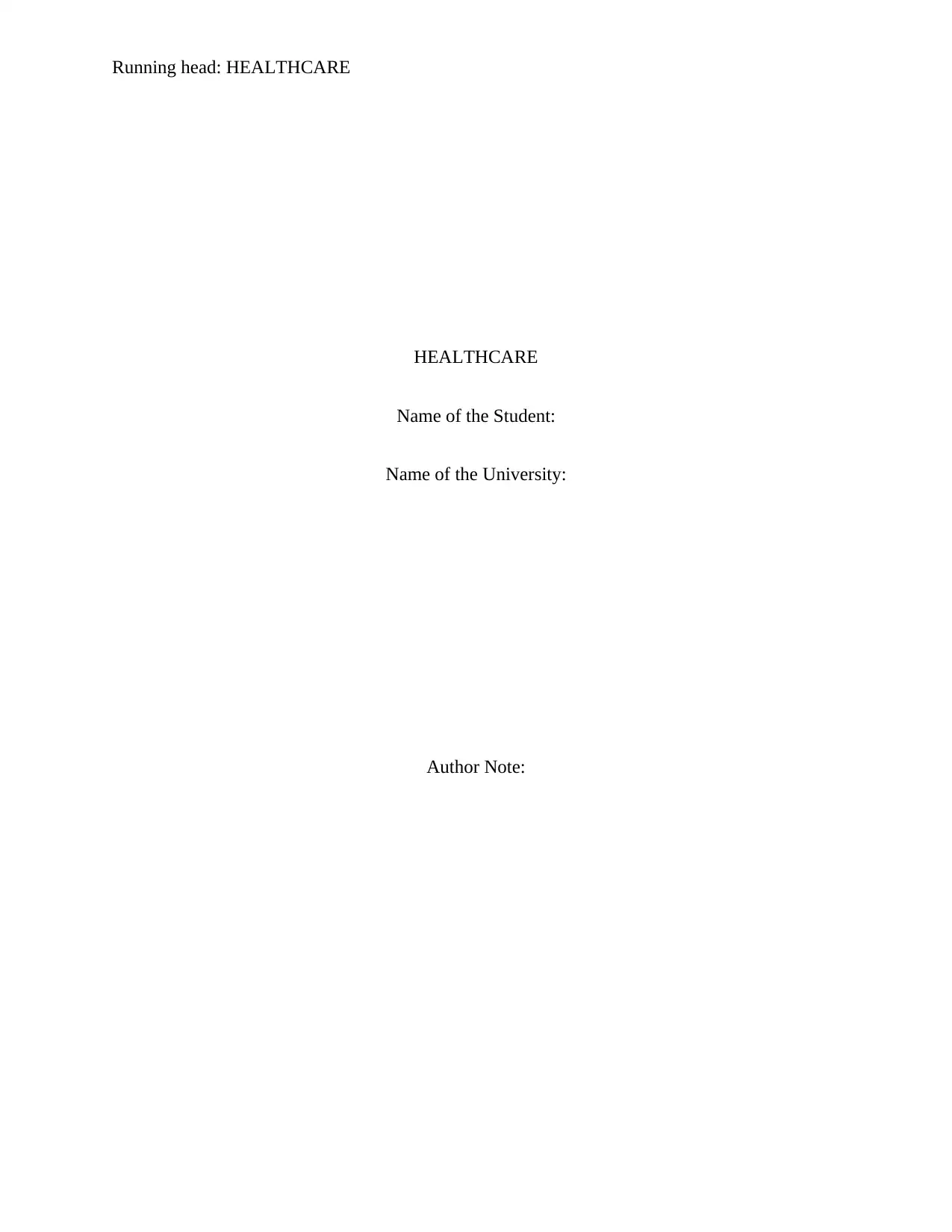
Running head: HEALTHCARE
HEALTHCARE
Name of the Student:
Name of the University:
Author Note:
HEALTHCARE
Name of the Student:
Name of the University:
Author Note:
Paraphrase This Document
Need a fresh take? Get an instant paraphrase of this document with our AI Paraphraser
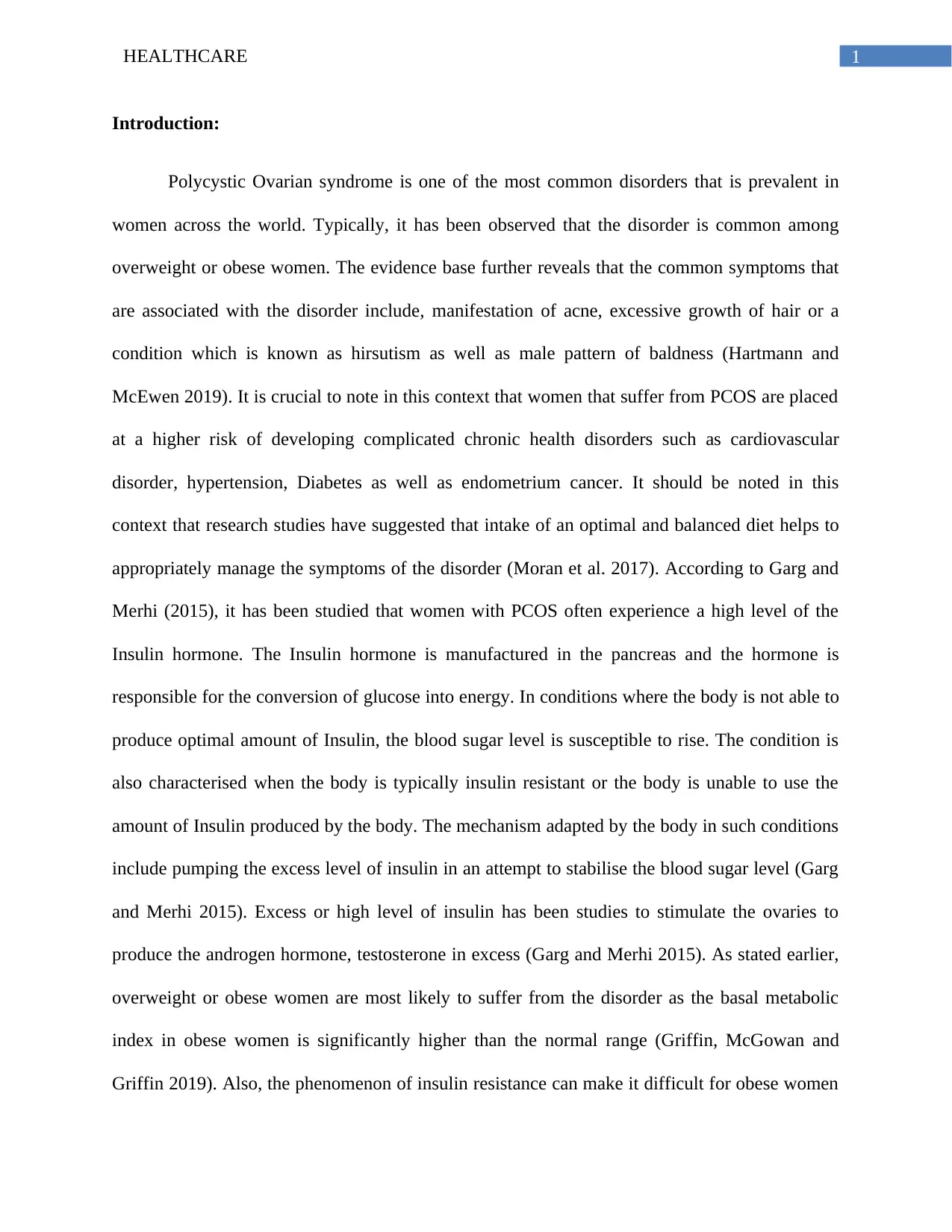
1HEALTHCARE
Introduction:
Polycystic Ovarian syndrome is one of the most common disorders that is prevalent in
women across the world. Typically, it has been observed that the disorder is common among
overweight or obese women. The evidence base further reveals that the common symptoms that
are associated with the disorder include, manifestation of acne, excessive growth of hair or a
condition which is known as hirsutism as well as male pattern of baldness (Hartmann and
McEwen 2019). It is crucial to note in this context that women that suffer from PCOS are placed
at a higher risk of developing complicated chronic health disorders such as cardiovascular
disorder, hypertension, Diabetes as well as endometrium cancer. It should be noted in this
context that research studies have suggested that intake of an optimal and balanced diet helps to
appropriately manage the symptoms of the disorder (Moran et al. 2017). According to Garg and
Merhi (2015), it has been studied that women with PCOS often experience a high level of the
Insulin hormone. The Insulin hormone is manufactured in the pancreas and the hormone is
responsible for the conversion of glucose into energy. In conditions where the body is not able to
produce optimal amount of Insulin, the blood sugar level is susceptible to rise. The condition is
also characterised when the body is typically insulin resistant or the body is unable to use the
amount of Insulin produced by the body. The mechanism adapted by the body in such conditions
include pumping the excess level of insulin in an attempt to stabilise the blood sugar level (Garg
and Merhi 2015). Excess or high level of insulin has been studies to stimulate the ovaries to
produce the androgen hormone, testosterone in excess (Garg and Merhi 2015). As stated earlier,
overweight or obese women are most likely to suffer from the disorder as the basal metabolic
index in obese women is significantly higher than the normal range (Griffin, McGowan and
Griffin 2019). Also, the phenomenon of insulin resistance can make it difficult for obese women
Introduction:
Polycystic Ovarian syndrome is one of the most common disorders that is prevalent in
women across the world. Typically, it has been observed that the disorder is common among
overweight or obese women. The evidence base further reveals that the common symptoms that
are associated with the disorder include, manifestation of acne, excessive growth of hair or a
condition which is known as hirsutism as well as male pattern of baldness (Hartmann and
McEwen 2019). It is crucial to note in this context that women that suffer from PCOS are placed
at a higher risk of developing complicated chronic health disorders such as cardiovascular
disorder, hypertension, Diabetes as well as endometrium cancer. It should be noted in this
context that research studies have suggested that intake of an optimal and balanced diet helps to
appropriately manage the symptoms of the disorder (Moran et al. 2017). According to Garg and
Merhi (2015), it has been studied that women with PCOS often experience a high level of the
Insulin hormone. The Insulin hormone is manufactured in the pancreas and the hormone is
responsible for the conversion of glucose into energy. In conditions where the body is not able to
produce optimal amount of Insulin, the blood sugar level is susceptible to rise. The condition is
also characterised when the body is typically insulin resistant or the body is unable to use the
amount of Insulin produced by the body. The mechanism adapted by the body in such conditions
include pumping the excess level of insulin in an attempt to stabilise the blood sugar level (Garg
and Merhi 2015). Excess or high level of insulin has been studies to stimulate the ovaries to
produce the androgen hormone, testosterone in excess (Garg and Merhi 2015). As stated earlier,
overweight or obese women are most likely to suffer from the disorder as the basal metabolic
index in obese women is significantly higher than the normal range (Griffin, McGowan and
Griffin 2019). Also, the phenomenon of insulin resistance can make it difficult for obese women
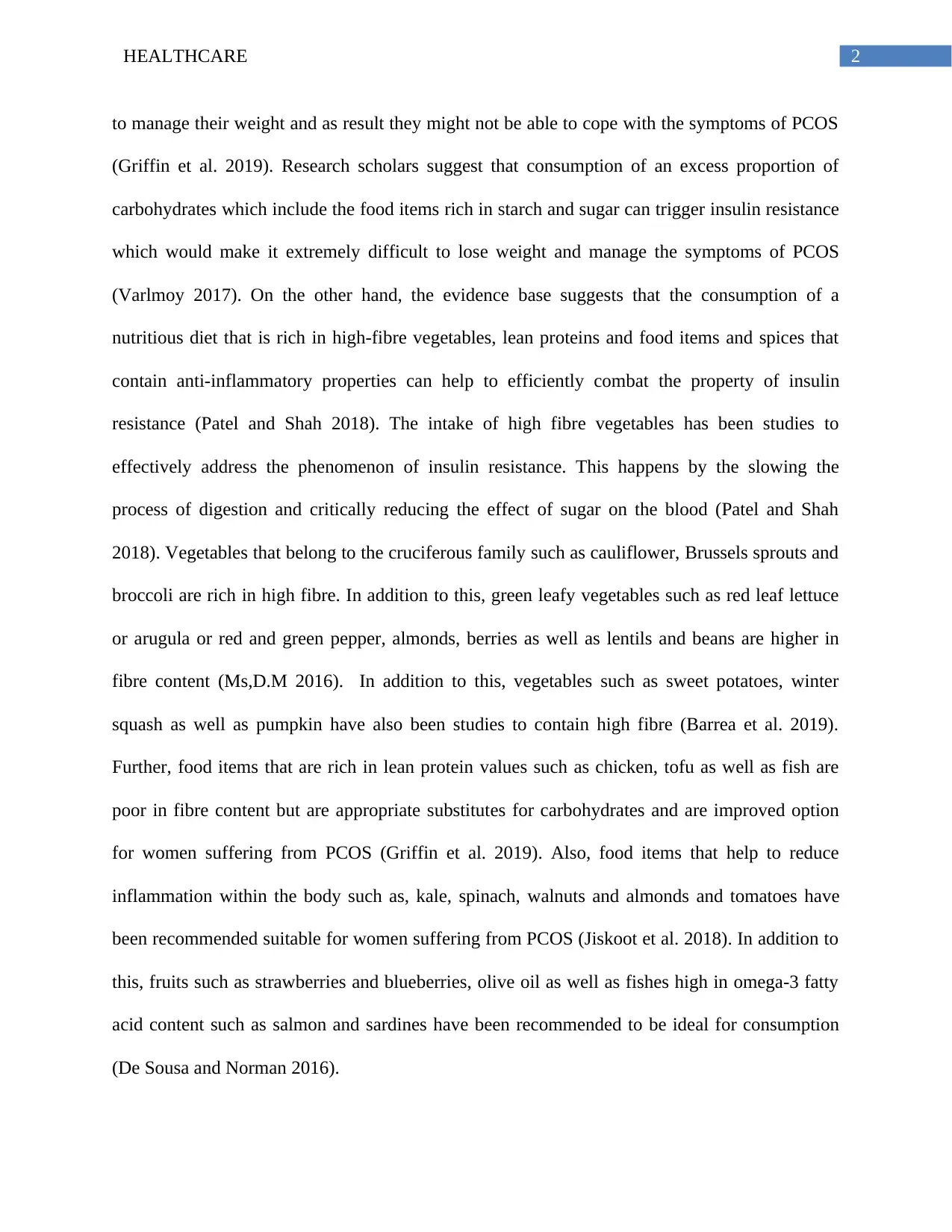
2HEALTHCARE
to manage their weight and as result they might not be able to cope with the symptoms of PCOS
(Griffin et al. 2019). Research scholars suggest that consumption of an excess proportion of
carbohydrates which include the food items rich in starch and sugar can trigger insulin resistance
which would make it extremely difficult to lose weight and manage the symptoms of PCOS
(Varlmoy 2017). On the other hand, the evidence base suggests that the consumption of a
nutritious diet that is rich in high-fibre vegetables, lean proteins and food items and spices that
contain anti-inflammatory properties can help to efficiently combat the property of insulin
resistance (Patel and Shah 2018). The intake of high fibre vegetables has been studies to
effectively address the phenomenon of insulin resistance. This happens by the slowing the
process of digestion and critically reducing the effect of sugar on the blood (Patel and Shah
2018). Vegetables that belong to the cruciferous family such as cauliflower, Brussels sprouts and
broccoli are rich in high fibre. In addition to this, green leafy vegetables such as red leaf lettuce
or arugula or red and green pepper, almonds, berries as well as lentils and beans are higher in
fibre content (Ms,D.M 2016). In addition to this, vegetables such as sweet potatoes, winter
squash as well as pumpkin have also been studies to contain high fibre (Barrea et al. 2019).
Further, food items that are rich in lean protein values such as chicken, tofu as well as fish are
poor in fibre content but are appropriate substitutes for carbohydrates and are improved option
for women suffering from PCOS (Griffin et al. 2019). Also, food items that help to reduce
inflammation within the body such as, kale, spinach, walnuts and almonds and tomatoes have
been recommended suitable for women suffering from PCOS (Jiskoot et al. 2018). In addition to
this, fruits such as strawberries and blueberries, olive oil as well as fishes high in omega-3 fatty
acid content such as salmon and sardines have been recommended to be ideal for consumption
(De Sousa and Norman 2016).
to manage their weight and as result they might not be able to cope with the symptoms of PCOS
(Griffin et al. 2019). Research scholars suggest that consumption of an excess proportion of
carbohydrates which include the food items rich in starch and sugar can trigger insulin resistance
which would make it extremely difficult to lose weight and manage the symptoms of PCOS
(Varlmoy 2017). On the other hand, the evidence base suggests that the consumption of a
nutritious diet that is rich in high-fibre vegetables, lean proteins and food items and spices that
contain anti-inflammatory properties can help to efficiently combat the property of insulin
resistance (Patel and Shah 2018). The intake of high fibre vegetables has been studies to
effectively address the phenomenon of insulin resistance. This happens by the slowing the
process of digestion and critically reducing the effect of sugar on the blood (Patel and Shah
2018). Vegetables that belong to the cruciferous family such as cauliflower, Brussels sprouts and
broccoli are rich in high fibre. In addition to this, green leafy vegetables such as red leaf lettuce
or arugula or red and green pepper, almonds, berries as well as lentils and beans are higher in
fibre content (Ms,D.M 2016). In addition to this, vegetables such as sweet potatoes, winter
squash as well as pumpkin have also been studies to contain high fibre (Barrea et al. 2019).
Further, food items that are rich in lean protein values such as chicken, tofu as well as fish are
poor in fibre content but are appropriate substitutes for carbohydrates and are improved option
for women suffering from PCOS (Griffin et al. 2019). Also, food items that help to reduce
inflammation within the body such as, kale, spinach, walnuts and almonds and tomatoes have
been recommended suitable for women suffering from PCOS (Jiskoot et al. 2018). In addition to
this, fruits such as strawberries and blueberries, olive oil as well as fishes high in omega-3 fatty
acid content such as salmon and sardines have been recommended to be ideal for consumption
(De Sousa and Norman 2016).
⊘ This is a preview!⊘
Do you want full access?
Subscribe today to unlock all pages.

Trusted by 1+ million students worldwide
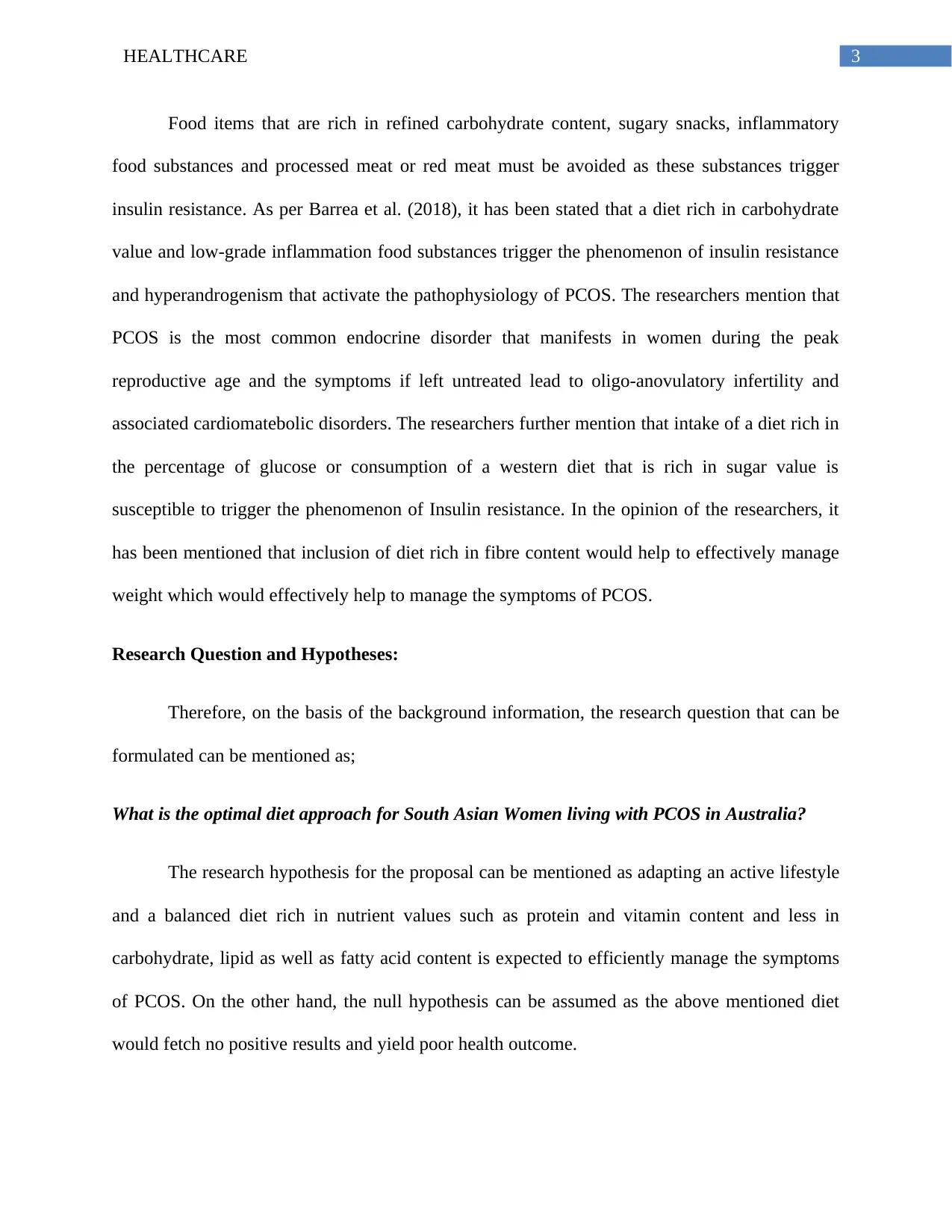
3HEALTHCARE
Food items that are rich in refined carbohydrate content, sugary snacks, inflammatory
food substances and processed meat or red meat must be avoided as these substances trigger
insulin resistance. As per Barrea et al. (2018), it has been stated that a diet rich in carbohydrate
value and low-grade inflammation food substances trigger the phenomenon of insulin resistance
and hyperandrogenism that activate the pathophysiology of PCOS. The researchers mention that
PCOS is the most common endocrine disorder that manifests in women during the peak
reproductive age and the symptoms if left untreated lead to oligo-anovulatory infertility and
associated cardiomatebolic disorders. The researchers further mention that intake of a diet rich in
the percentage of glucose or consumption of a western diet that is rich in sugar value is
susceptible to trigger the phenomenon of Insulin resistance. In the opinion of the researchers, it
has been mentioned that inclusion of diet rich in fibre content would help to effectively manage
weight which would effectively help to manage the symptoms of PCOS.
Research Question and Hypotheses:
Therefore, on the basis of the background information, the research question that can be
formulated can be mentioned as;
What is the optimal diet approach for South Asian Women living with PCOS in Australia?
The research hypothesis for the proposal can be mentioned as adapting an active lifestyle
and a balanced diet rich in nutrient values such as protein and vitamin content and less in
carbohydrate, lipid as well as fatty acid content is expected to efficiently manage the symptoms
of PCOS. On the other hand, the null hypothesis can be assumed as the above mentioned diet
would fetch no positive results and yield poor health outcome.
Food items that are rich in refined carbohydrate content, sugary snacks, inflammatory
food substances and processed meat or red meat must be avoided as these substances trigger
insulin resistance. As per Barrea et al. (2018), it has been stated that a diet rich in carbohydrate
value and low-grade inflammation food substances trigger the phenomenon of insulin resistance
and hyperandrogenism that activate the pathophysiology of PCOS. The researchers mention that
PCOS is the most common endocrine disorder that manifests in women during the peak
reproductive age and the symptoms if left untreated lead to oligo-anovulatory infertility and
associated cardiomatebolic disorders. The researchers further mention that intake of a diet rich in
the percentage of glucose or consumption of a western diet that is rich in sugar value is
susceptible to trigger the phenomenon of Insulin resistance. In the opinion of the researchers, it
has been mentioned that inclusion of diet rich in fibre content would help to effectively manage
weight which would effectively help to manage the symptoms of PCOS.
Research Question and Hypotheses:
Therefore, on the basis of the background information, the research question that can be
formulated can be mentioned as;
What is the optimal diet approach for South Asian Women living with PCOS in Australia?
The research hypothesis for the proposal can be mentioned as adapting an active lifestyle
and a balanced diet rich in nutrient values such as protein and vitamin content and less in
carbohydrate, lipid as well as fatty acid content is expected to efficiently manage the symptoms
of PCOS. On the other hand, the null hypothesis can be assumed as the above mentioned diet
would fetch no positive results and yield poor health outcome.
Paraphrase This Document
Need a fresh take? Get an instant paraphrase of this document with our AI Paraphraser
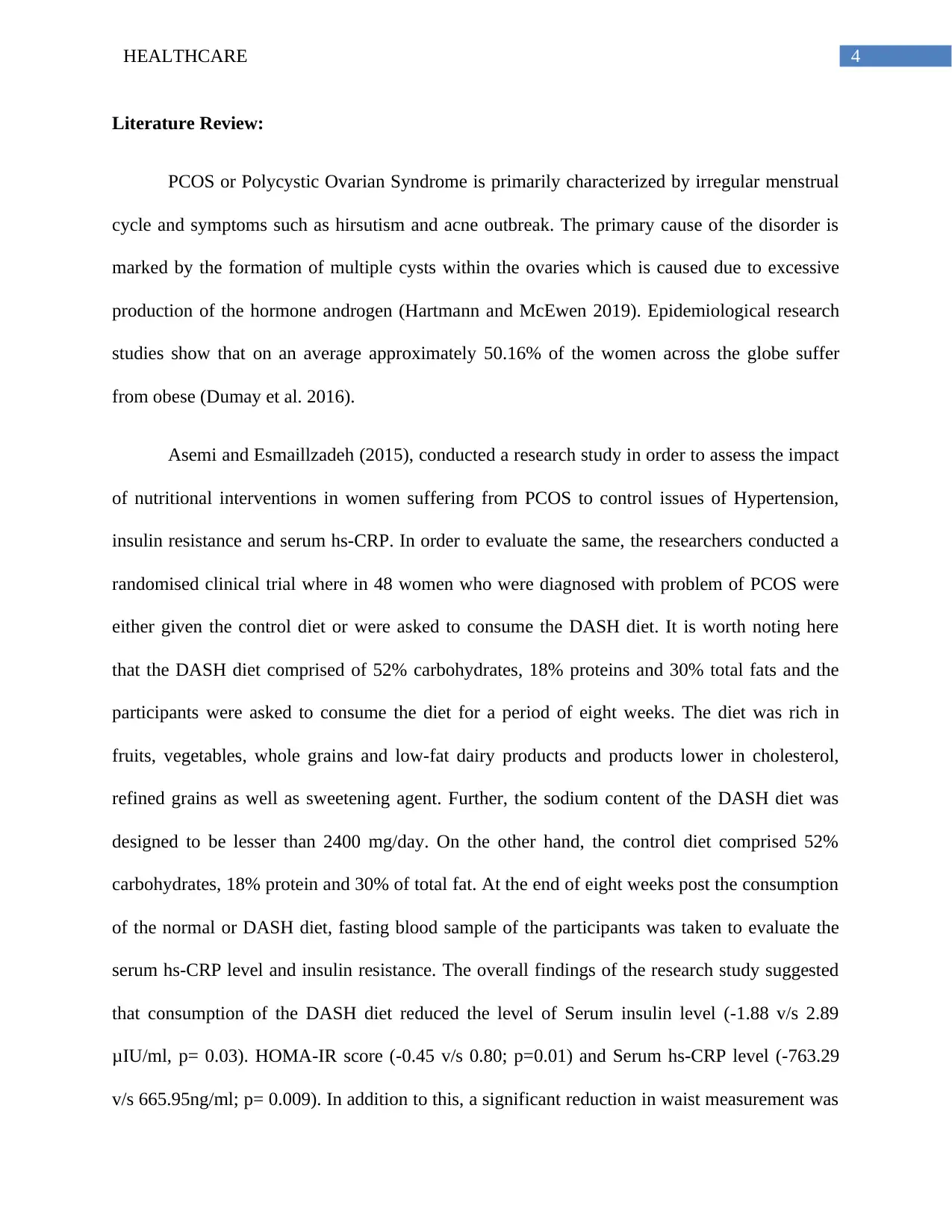
4HEALTHCARE
Literature Review:
PCOS or Polycystic Ovarian Syndrome is primarily characterized by irregular menstrual
cycle and symptoms such as hirsutism and acne outbreak. The primary cause of the disorder is
marked by the formation of multiple cysts within the ovaries which is caused due to excessive
production of the hormone androgen (Hartmann and McEwen 2019). Epidemiological research
studies show that on an average approximately 50.16% of the women across the globe suffer
from obese (Dumay et al. 2016).
Asemi and Esmaillzadeh (2015), conducted a research study in order to assess the impact
of nutritional interventions in women suffering from PCOS to control issues of Hypertension,
insulin resistance and serum hs-CRP. In order to evaluate the same, the researchers conducted a
randomised clinical trial where in 48 women who were diagnosed with problem of PCOS were
either given the control diet or were asked to consume the DASH diet. It is worth noting here
that the DASH diet comprised of 52% carbohydrates, 18% proteins and 30% total fats and the
participants were asked to consume the diet for a period of eight weeks. The diet was rich in
fruits, vegetables, whole grains and low-fat dairy products and products lower in cholesterol,
refined grains as well as sweetening agent. Further, the sodium content of the DASH diet was
designed to be lesser than 2400 mg/day. On the other hand, the control diet comprised 52%
carbohydrates, 18% protein and 30% of total fat. At the end of eight weeks post the consumption
of the normal or DASH diet, fasting blood sample of the participants was taken to evaluate the
serum hs-CRP level and insulin resistance. The overall findings of the research study suggested
that consumption of the DASH diet reduced the level of Serum insulin level (-1.88 v/s 2.89
μIU/ml, p= 0.03). HOMA-IR score (-0.45 v/s 0.80; p=0.01) and Serum hs-CRP level (-763.29
v/s 665.95ng/ml; p= 0.009). In addition to this, a significant reduction in waist measurement was
Literature Review:
PCOS or Polycystic Ovarian Syndrome is primarily characterized by irregular menstrual
cycle and symptoms such as hirsutism and acne outbreak. The primary cause of the disorder is
marked by the formation of multiple cysts within the ovaries which is caused due to excessive
production of the hormone androgen (Hartmann and McEwen 2019). Epidemiological research
studies show that on an average approximately 50.16% of the women across the globe suffer
from obese (Dumay et al. 2016).
Asemi and Esmaillzadeh (2015), conducted a research study in order to assess the impact
of nutritional interventions in women suffering from PCOS to control issues of Hypertension,
insulin resistance and serum hs-CRP. In order to evaluate the same, the researchers conducted a
randomised clinical trial where in 48 women who were diagnosed with problem of PCOS were
either given the control diet or were asked to consume the DASH diet. It is worth noting here
that the DASH diet comprised of 52% carbohydrates, 18% proteins and 30% total fats and the
participants were asked to consume the diet for a period of eight weeks. The diet was rich in
fruits, vegetables, whole grains and low-fat dairy products and products lower in cholesterol,
refined grains as well as sweetening agent. Further, the sodium content of the DASH diet was
designed to be lesser than 2400 mg/day. On the other hand, the control diet comprised 52%
carbohydrates, 18% protein and 30% of total fat. At the end of eight weeks post the consumption
of the normal or DASH diet, fasting blood sample of the participants was taken to evaluate the
serum hs-CRP level and insulin resistance. The overall findings of the research study suggested
that consumption of the DASH diet reduced the level of Serum insulin level (-1.88 v/s 2.89
μIU/ml, p= 0.03). HOMA-IR score (-0.45 v/s 0.80; p=0.01) and Serum hs-CRP level (-763.29
v/s 665.95ng/ml; p= 0.009). In addition to this, a significant reduction in waist measurement was
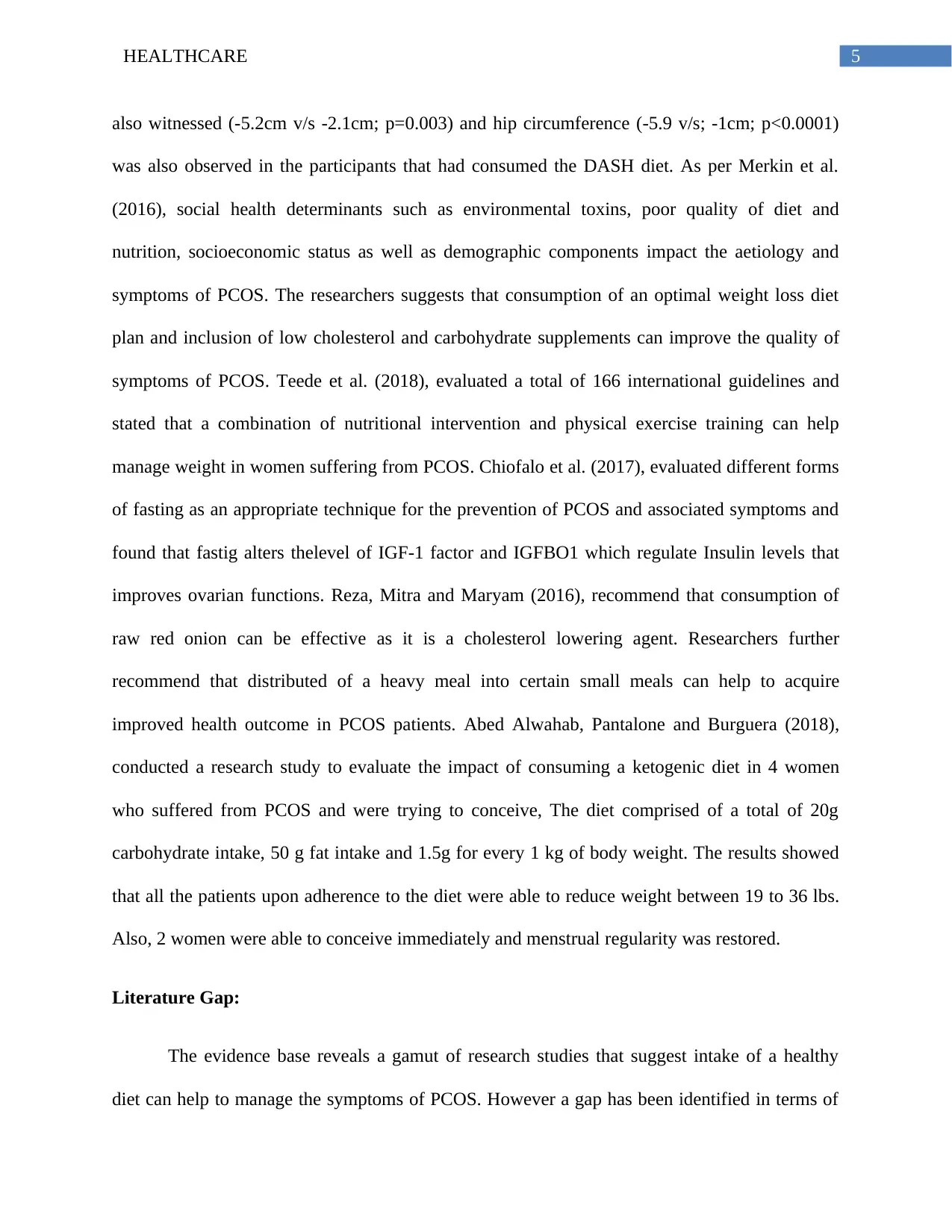
5HEALTHCARE
also witnessed (-5.2cm v/s -2.1cm; p=0.003) and hip circumference (-5.9 v/s; -1cm; p<0.0001)
was also observed in the participants that had consumed the DASH diet. As per Merkin et al.
(2016), social health determinants such as environmental toxins, poor quality of diet and
nutrition, socioeconomic status as well as demographic components impact the aetiology and
symptoms of PCOS. The researchers suggests that consumption of an optimal weight loss diet
plan and inclusion of low cholesterol and carbohydrate supplements can improve the quality of
symptoms of PCOS. Teede et al. (2018), evaluated a total of 166 international guidelines and
stated that a combination of nutritional intervention and physical exercise training can help
manage weight in women suffering from PCOS. Chiofalo et al. (2017), evaluated different forms
of fasting as an appropriate technique for the prevention of PCOS and associated symptoms and
found that fastig alters thelevel of IGF-1 factor and IGFBO1 which regulate Insulin levels that
improves ovarian functions. Reza, Mitra and Maryam (2016), recommend that consumption of
raw red onion can be effective as it is a cholesterol lowering agent. Researchers further
recommend that distributed of a heavy meal into certain small meals can help to acquire
improved health outcome in PCOS patients. Abed Alwahab, Pantalone and Burguera (2018),
conducted a research study to evaluate the impact of consuming a ketogenic diet in 4 women
who suffered from PCOS and were trying to conceive, The diet comprised of a total of 20g
carbohydrate intake, 50 g fat intake and 1.5g for every 1 kg of body weight. The results showed
that all the patients upon adherence to the diet were able to reduce weight between 19 to 36 lbs.
Also, 2 women were able to conceive immediately and menstrual regularity was restored.
Literature Gap:
The evidence base reveals a gamut of research studies that suggest intake of a healthy
diet can help to manage the symptoms of PCOS. However a gap has been identified in terms of
also witnessed (-5.2cm v/s -2.1cm; p=0.003) and hip circumference (-5.9 v/s; -1cm; p<0.0001)
was also observed in the participants that had consumed the DASH diet. As per Merkin et al.
(2016), social health determinants such as environmental toxins, poor quality of diet and
nutrition, socioeconomic status as well as demographic components impact the aetiology and
symptoms of PCOS. The researchers suggests that consumption of an optimal weight loss diet
plan and inclusion of low cholesterol and carbohydrate supplements can improve the quality of
symptoms of PCOS. Teede et al. (2018), evaluated a total of 166 international guidelines and
stated that a combination of nutritional intervention and physical exercise training can help
manage weight in women suffering from PCOS. Chiofalo et al. (2017), evaluated different forms
of fasting as an appropriate technique for the prevention of PCOS and associated symptoms and
found that fastig alters thelevel of IGF-1 factor and IGFBO1 which regulate Insulin levels that
improves ovarian functions. Reza, Mitra and Maryam (2016), recommend that consumption of
raw red onion can be effective as it is a cholesterol lowering agent. Researchers further
recommend that distributed of a heavy meal into certain small meals can help to acquire
improved health outcome in PCOS patients. Abed Alwahab, Pantalone and Burguera (2018),
conducted a research study to evaluate the impact of consuming a ketogenic diet in 4 women
who suffered from PCOS and were trying to conceive, The diet comprised of a total of 20g
carbohydrate intake, 50 g fat intake and 1.5g for every 1 kg of body weight. The results showed
that all the patients upon adherence to the diet were able to reduce weight between 19 to 36 lbs.
Also, 2 women were able to conceive immediately and menstrual regularity was restored.
Literature Gap:
The evidence base reveals a gamut of research studies that suggest intake of a healthy
diet can help to manage the symptoms of PCOS. However a gap has been identified in terms of
⊘ This is a preview!⊘
Do you want full access?
Subscribe today to unlock all pages.

Trusted by 1+ million students worldwide
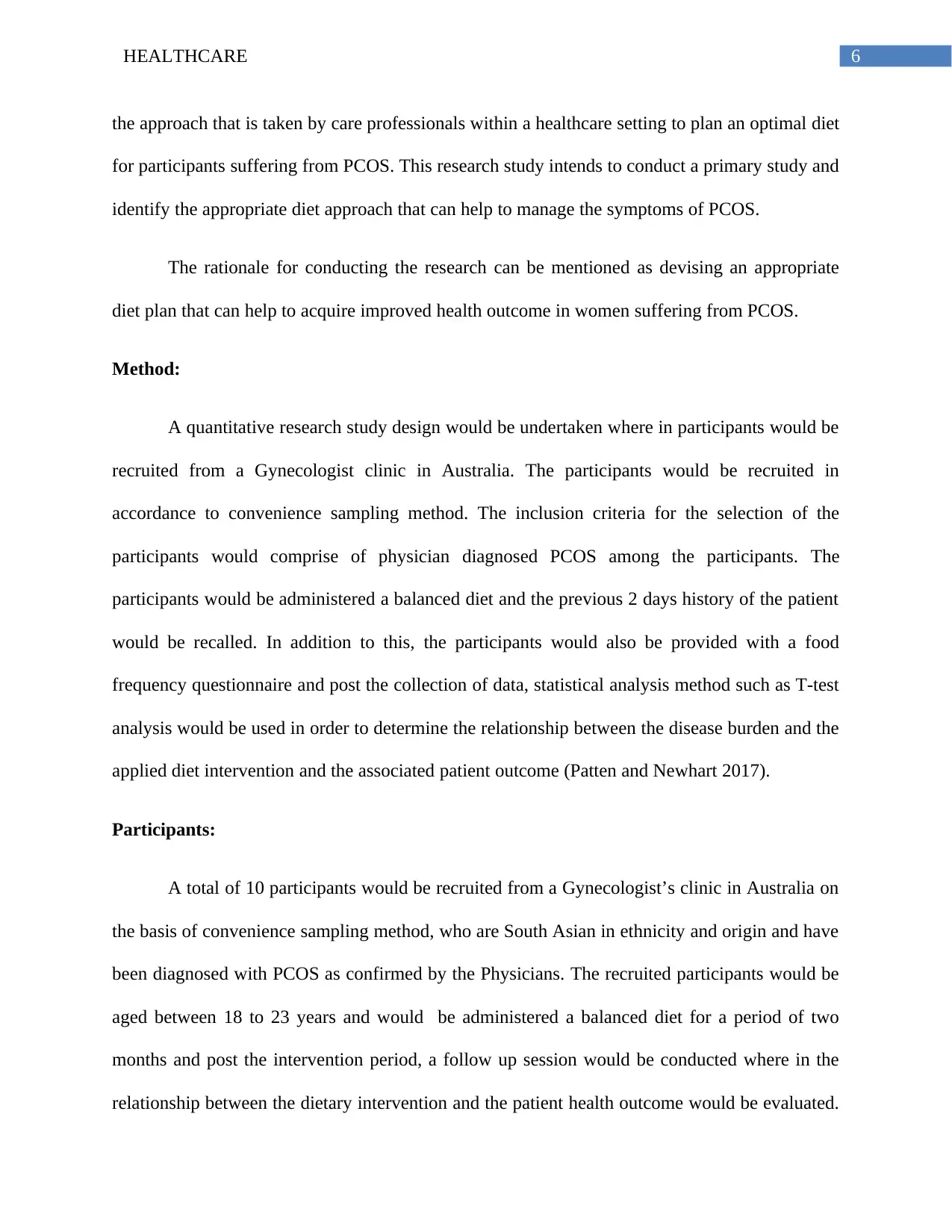
6HEALTHCARE
the approach that is taken by care professionals within a healthcare setting to plan an optimal diet
for participants suffering from PCOS. This research study intends to conduct a primary study and
identify the appropriate diet approach that can help to manage the symptoms of PCOS.
The rationale for conducting the research can be mentioned as devising an appropriate
diet plan that can help to acquire improved health outcome in women suffering from PCOS.
Method:
A quantitative research study design would be undertaken where in participants would be
recruited from a Gynecologist clinic in Australia. The participants would be recruited in
accordance to convenience sampling method. The inclusion criteria for the selection of the
participants would comprise of physician diagnosed PCOS among the participants. The
participants would be administered a balanced diet and the previous 2 days history of the patient
would be recalled. In addition to this, the participants would also be provided with a food
frequency questionnaire and post the collection of data, statistical analysis method such as T-test
analysis would be used in order to determine the relationship between the disease burden and the
applied diet intervention and the associated patient outcome (Patten and Newhart 2017).
Participants:
A total of 10 participants would be recruited from a Gynecologist’s clinic in Australia on
the basis of convenience sampling method, who are South Asian in ethnicity and origin and have
been diagnosed with PCOS as confirmed by the Physicians. The recruited participants would be
aged between 18 to 23 years and would be administered a balanced diet for a period of two
months and post the intervention period, a follow up session would be conducted where in the
relationship between the dietary intervention and the patient health outcome would be evaluated.
the approach that is taken by care professionals within a healthcare setting to plan an optimal diet
for participants suffering from PCOS. This research study intends to conduct a primary study and
identify the appropriate diet approach that can help to manage the symptoms of PCOS.
The rationale for conducting the research can be mentioned as devising an appropriate
diet plan that can help to acquire improved health outcome in women suffering from PCOS.
Method:
A quantitative research study design would be undertaken where in participants would be
recruited from a Gynecologist clinic in Australia. The participants would be recruited in
accordance to convenience sampling method. The inclusion criteria for the selection of the
participants would comprise of physician diagnosed PCOS among the participants. The
participants would be administered a balanced diet and the previous 2 days history of the patient
would be recalled. In addition to this, the participants would also be provided with a food
frequency questionnaire and post the collection of data, statistical analysis method such as T-test
analysis would be used in order to determine the relationship between the disease burden and the
applied diet intervention and the associated patient outcome (Patten and Newhart 2017).
Participants:
A total of 10 participants would be recruited from a Gynecologist’s clinic in Australia on
the basis of convenience sampling method, who are South Asian in ethnicity and origin and have
been diagnosed with PCOS as confirmed by the Physicians. The recruited participants would be
aged between 18 to 23 years and would be administered a balanced diet for a period of two
months and post the intervention period, a follow up session would be conducted where in the
relationship between the dietary intervention and the patient health outcome would be evaluated.
Paraphrase This Document
Need a fresh take? Get an instant paraphrase of this document with our AI Paraphraser
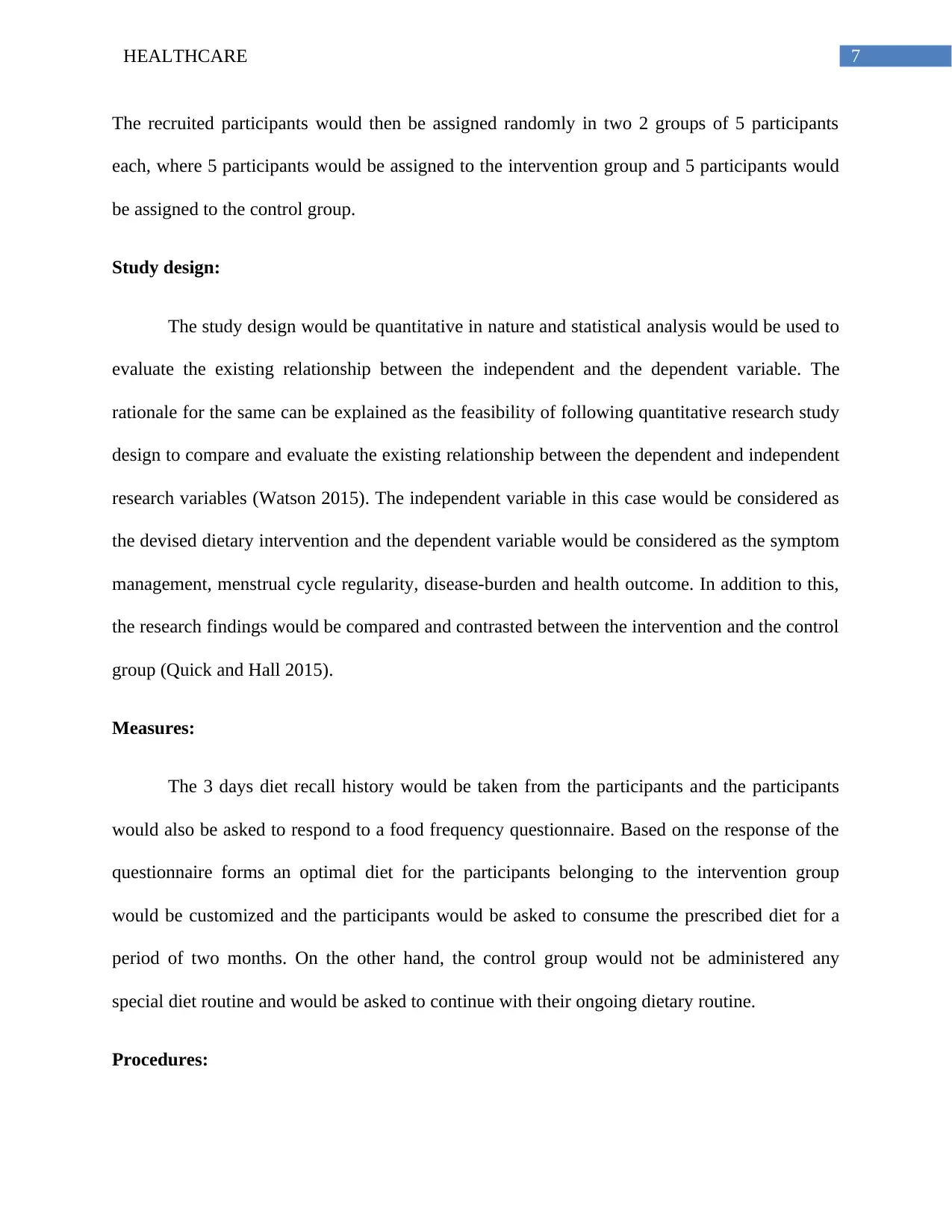
7HEALTHCARE
The recruited participants would then be assigned randomly in two 2 groups of 5 participants
each, where 5 participants would be assigned to the intervention group and 5 participants would
be assigned to the control group.
Study design:
The study design would be quantitative in nature and statistical analysis would be used to
evaluate the existing relationship between the independent and the dependent variable. The
rationale for the same can be explained as the feasibility of following quantitative research study
design to compare and evaluate the existing relationship between the dependent and independent
research variables (Watson 2015). The independent variable in this case would be considered as
the devised dietary intervention and the dependent variable would be considered as the symptom
management, menstrual cycle regularity, disease-burden and health outcome. In addition to this,
the research findings would be compared and contrasted between the intervention and the control
group (Quick and Hall 2015).
Measures:
The 3 days diet recall history would be taken from the participants and the participants
would also be asked to respond to a food frequency questionnaire. Based on the response of the
questionnaire forms an optimal diet for the participants belonging to the intervention group
would be customized and the participants would be asked to consume the prescribed diet for a
period of two months. On the other hand, the control group would not be administered any
special diet routine and would be asked to continue with their ongoing dietary routine.
Procedures:
The recruited participants would then be assigned randomly in two 2 groups of 5 participants
each, where 5 participants would be assigned to the intervention group and 5 participants would
be assigned to the control group.
Study design:
The study design would be quantitative in nature and statistical analysis would be used to
evaluate the existing relationship between the independent and the dependent variable. The
rationale for the same can be explained as the feasibility of following quantitative research study
design to compare and evaluate the existing relationship between the dependent and independent
research variables (Watson 2015). The independent variable in this case would be considered as
the devised dietary intervention and the dependent variable would be considered as the symptom
management, menstrual cycle regularity, disease-burden and health outcome. In addition to this,
the research findings would be compared and contrasted between the intervention and the control
group (Quick and Hall 2015).
Measures:
The 3 days diet recall history would be taken from the participants and the participants
would also be asked to respond to a food frequency questionnaire. Based on the response of the
questionnaire forms an optimal diet for the participants belonging to the intervention group
would be customized and the participants would be asked to consume the prescribed diet for a
period of two months. On the other hand, the control group would not be administered any
special diet routine and would be asked to continue with their ongoing dietary routine.
Procedures:
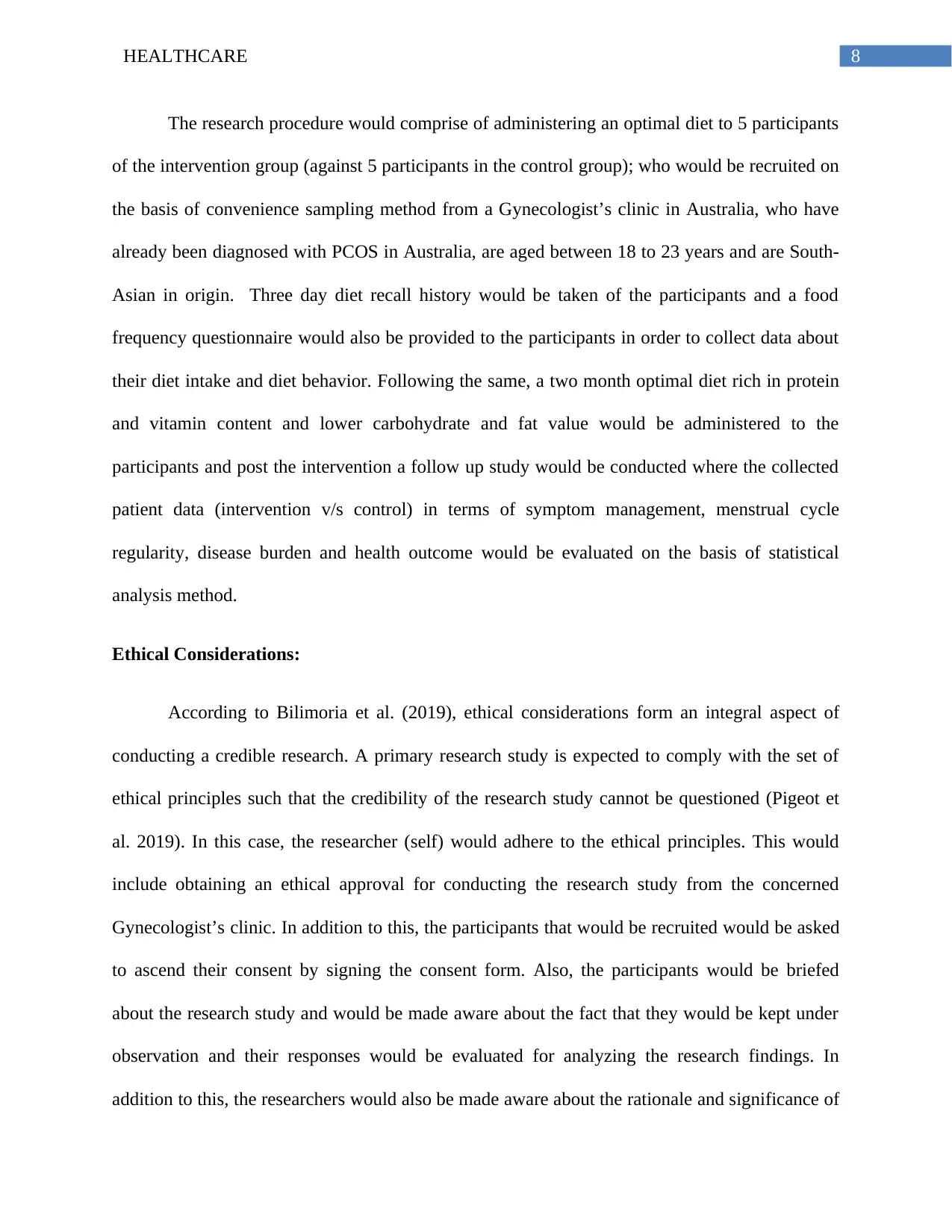
8HEALTHCARE
The research procedure would comprise of administering an optimal diet to 5 participants
of the intervention group (against 5 participants in the control group); who would be recruited on
the basis of convenience sampling method from a Gynecologist’s clinic in Australia, who have
already been diagnosed with PCOS in Australia, are aged between 18 to 23 years and are South-
Asian in origin. Three day diet recall history would be taken of the participants and a food
frequency questionnaire would also be provided to the participants in order to collect data about
their diet intake and diet behavior. Following the same, a two month optimal diet rich in protein
and vitamin content and lower carbohydrate and fat value would be administered to the
participants and post the intervention a follow up study would be conducted where the collected
patient data (intervention v/s control) in terms of symptom management, menstrual cycle
regularity, disease burden and health outcome would be evaluated on the basis of statistical
analysis method.
Ethical Considerations:
According to Bilimoria et al. (2019), ethical considerations form an integral aspect of
conducting a credible research. A primary research study is expected to comply with the set of
ethical principles such that the credibility of the research study cannot be questioned (Pigeot et
al. 2019). In this case, the researcher (self) would adhere to the ethical principles. This would
include obtaining an ethical approval for conducting the research study from the concerned
Gynecologist’s clinic. In addition to this, the participants that would be recruited would be asked
to ascend their consent by signing the consent form. Also, the participants would be briefed
about the research study and would be made aware about the fact that they would be kept under
observation and their responses would be evaluated for analyzing the research findings. In
addition to this, the researchers would also be made aware about the rationale and significance of
The research procedure would comprise of administering an optimal diet to 5 participants
of the intervention group (against 5 participants in the control group); who would be recruited on
the basis of convenience sampling method from a Gynecologist’s clinic in Australia, who have
already been diagnosed with PCOS in Australia, are aged between 18 to 23 years and are South-
Asian in origin. Three day diet recall history would be taken of the participants and a food
frequency questionnaire would also be provided to the participants in order to collect data about
their diet intake and diet behavior. Following the same, a two month optimal diet rich in protein
and vitamin content and lower carbohydrate and fat value would be administered to the
participants and post the intervention a follow up study would be conducted where the collected
patient data (intervention v/s control) in terms of symptom management, menstrual cycle
regularity, disease burden and health outcome would be evaluated on the basis of statistical
analysis method.
Ethical Considerations:
According to Bilimoria et al. (2019), ethical considerations form an integral aspect of
conducting a credible research. A primary research study is expected to comply with the set of
ethical principles such that the credibility of the research study cannot be questioned (Pigeot et
al. 2019). In this case, the researcher (self) would adhere to the ethical principles. This would
include obtaining an ethical approval for conducting the research study from the concerned
Gynecologist’s clinic. In addition to this, the participants that would be recruited would be asked
to ascend their consent by signing the consent form. Also, the participants would be briefed
about the research study and would be made aware about the fact that they would be kept under
observation and their responses would be evaluated for analyzing the research findings. In
addition to this, the researchers would also be made aware about the rationale and significance of
⊘ This is a preview!⊘
Do you want full access?
Subscribe today to unlock all pages.

Trusted by 1+ million students worldwide
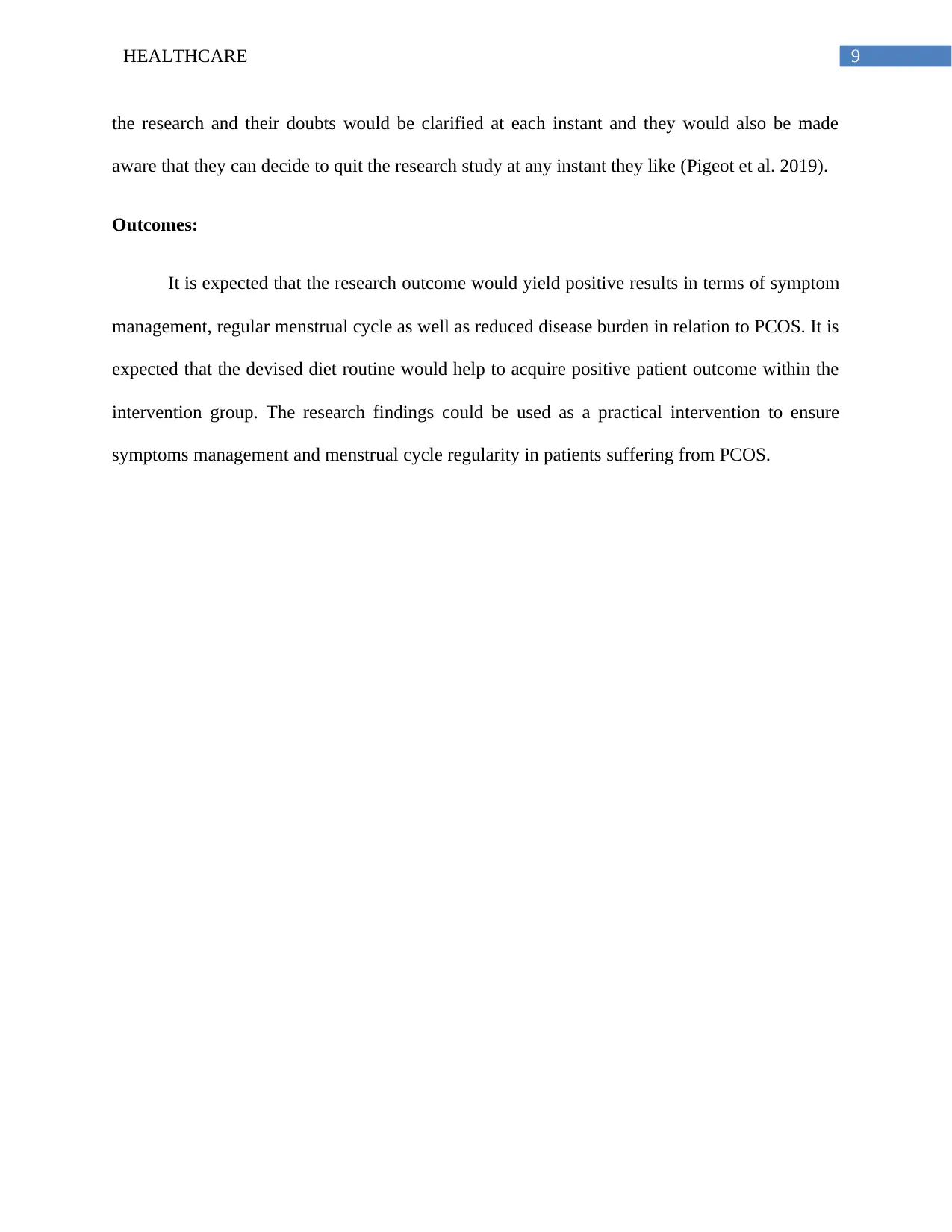
9HEALTHCARE
the research and their doubts would be clarified at each instant and they would also be made
aware that they can decide to quit the research study at any instant they like (Pigeot et al. 2019).
Outcomes:
It is expected that the research outcome would yield positive results in terms of symptom
management, regular menstrual cycle as well as reduced disease burden in relation to PCOS. It is
expected that the devised diet routine would help to acquire positive patient outcome within the
intervention group. The research findings could be used as a practical intervention to ensure
symptoms management and menstrual cycle regularity in patients suffering from PCOS.
the research and their doubts would be clarified at each instant and they would also be made
aware that they can decide to quit the research study at any instant they like (Pigeot et al. 2019).
Outcomes:
It is expected that the research outcome would yield positive results in terms of symptom
management, regular menstrual cycle as well as reduced disease burden in relation to PCOS. It is
expected that the devised diet routine would help to acquire positive patient outcome within the
intervention group. The research findings could be used as a practical intervention to ensure
symptoms management and menstrual cycle regularity in patients suffering from PCOS.
Paraphrase This Document
Need a fresh take? Get an instant paraphrase of this document with our AI Paraphraser
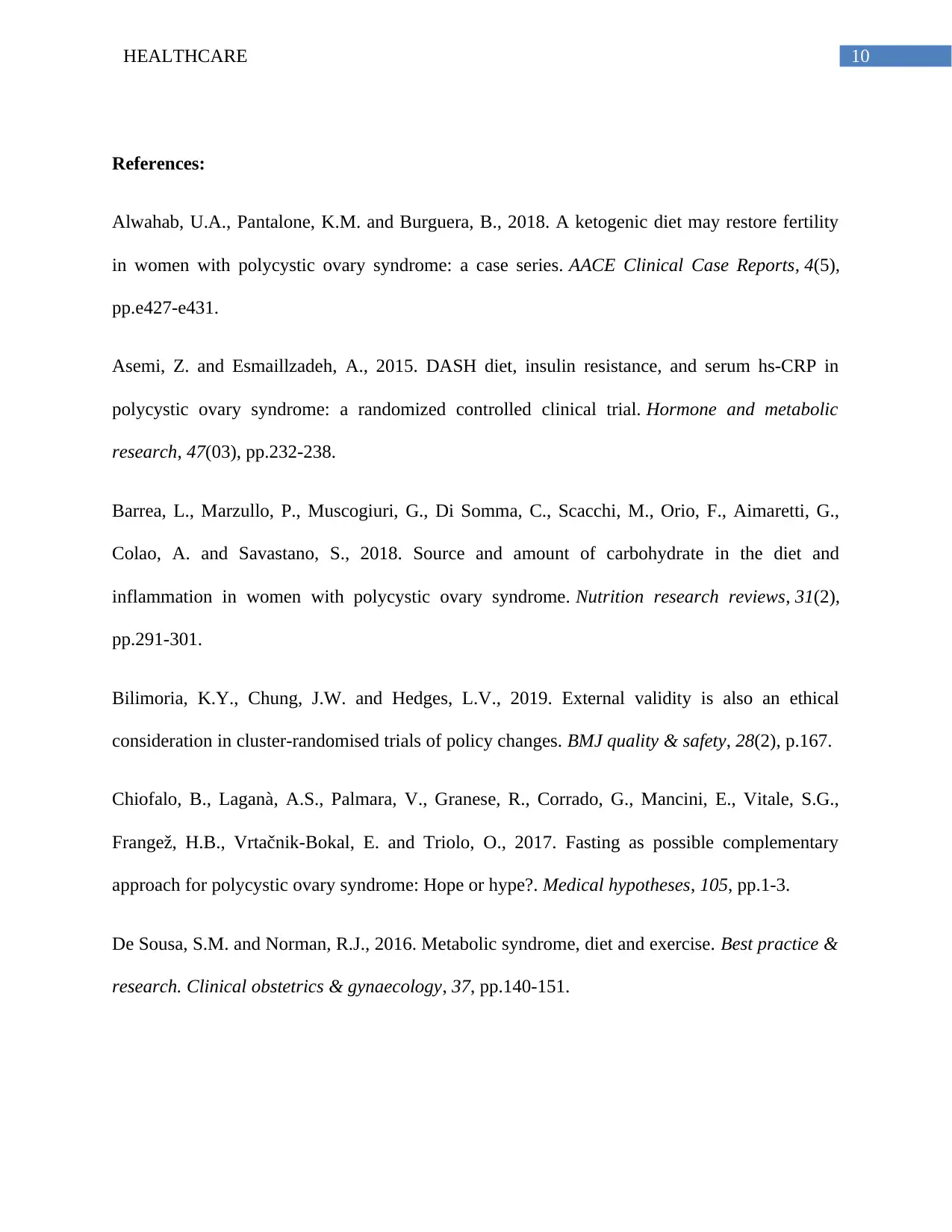
10HEALTHCARE
References:
Alwahab, U.A., Pantalone, K.M. and Burguera, B., 2018. A ketogenic diet may restore fertility
in women with polycystic ovary syndrome: a case series. AACE Clinical Case Reports, 4(5),
pp.e427-e431.
Asemi, Z. and Esmaillzadeh, A., 2015. DASH diet, insulin resistance, and serum hs-CRP in
polycystic ovary syndrome: a randomized controlled clinical trial. Hormone and metabolic
research, 47(03), pp.232-238.
Barrea, L., Marzullo, P., Muscogiuri, G., Di Somma, C., Scacchi, M., Orio, F., Aimaretti, G.,
Colao, A. and Savastano, S., 2018. Source and amount of carbohydrate in the diet and
inflammation in women with polycystic ovary syndrome. Nutrition research reviews, 31(2),
pp.291-301.
Bilimoria, K.Y., Chung, J.W. and Hedges, L.V., 2019. External validity is also an ethical
consideration in cluster-randomised trials of policy changes. BMJ quality & safety, 28(2), p.167.
Chiofalo, B., Laganà, A.S., Palmara, V., Granese, R., Corrado, G., Mancini, E., Vitale, S.G.,
Frangež, H.B., Vrtačnik-Bokal, E. and Triolo, O., 2017. Fasting as possible complementary
approach for polycystic ovary syndrome: Hope or hype?. Medical hypotheses, 105, pp.1-3.
De Sousa, S.M. and Norman, R.J., 2016. Metabolic syndrome, diet and exercise. Best practice &
research. Clinical obstetrics & gynaecology, 37, pp.140-151.
References:
Alwahab, U.A., Pantalone, K.M. and Burguera, B., 2018. A ketogenic diet may restore fertility
in women with polycystic ovary syndrome: a case series. AACE Clinical Case Reports, 4(5),
pp.e427-e431.
Asemi, Z. and Esmaillzadeh, A., 2015. DASH diet, insulin resistance, and serum hs-CRP in
polycystic ovary syndrome: a randomized controlled clinical trial. Hormone and metabolic
research, 47(03), pp.232-238.
Barrea, L., Marzullo, P., Muscogiuri, G., Di Somma, C., Scacchi, M., Orio, F., Aimaretti, G.,
Colao, A. and Savastano, S., 2018. Source and amount of carbohydrate in the diet and
inflammation in women with polycystic ovary syndrome. Nutrition research reviews, 31(2),
pp.291-301.
Bilimoria, K.Y., Chung, J.W. and Hedges, L.V., 2019. External validity is also an ethical
consideration in cluster-randomised trials of policy changes. BMJ quality & safety, 28(2), p.167.
Chiofalo, B., Laganà, A.S., Palmara, V., Granese, R., Corrado, G., Mancini, E., Vitale, S.G.,
Frangež, H.B., Vrtačnik-Bokal, E. and Triolo, O., 2017. Fasting as possible complementary
approach for polycystic ovary syndrome: Hope or hype?. Medical hypotheses, 105, pp.1-3.
De Sousa, S.M. and Norman, R.J., 2016. Metabolic syndrome, diet and exercise. Best practice &
research. Clinical obstetrics & gynaecology, 37, pp.140-151.
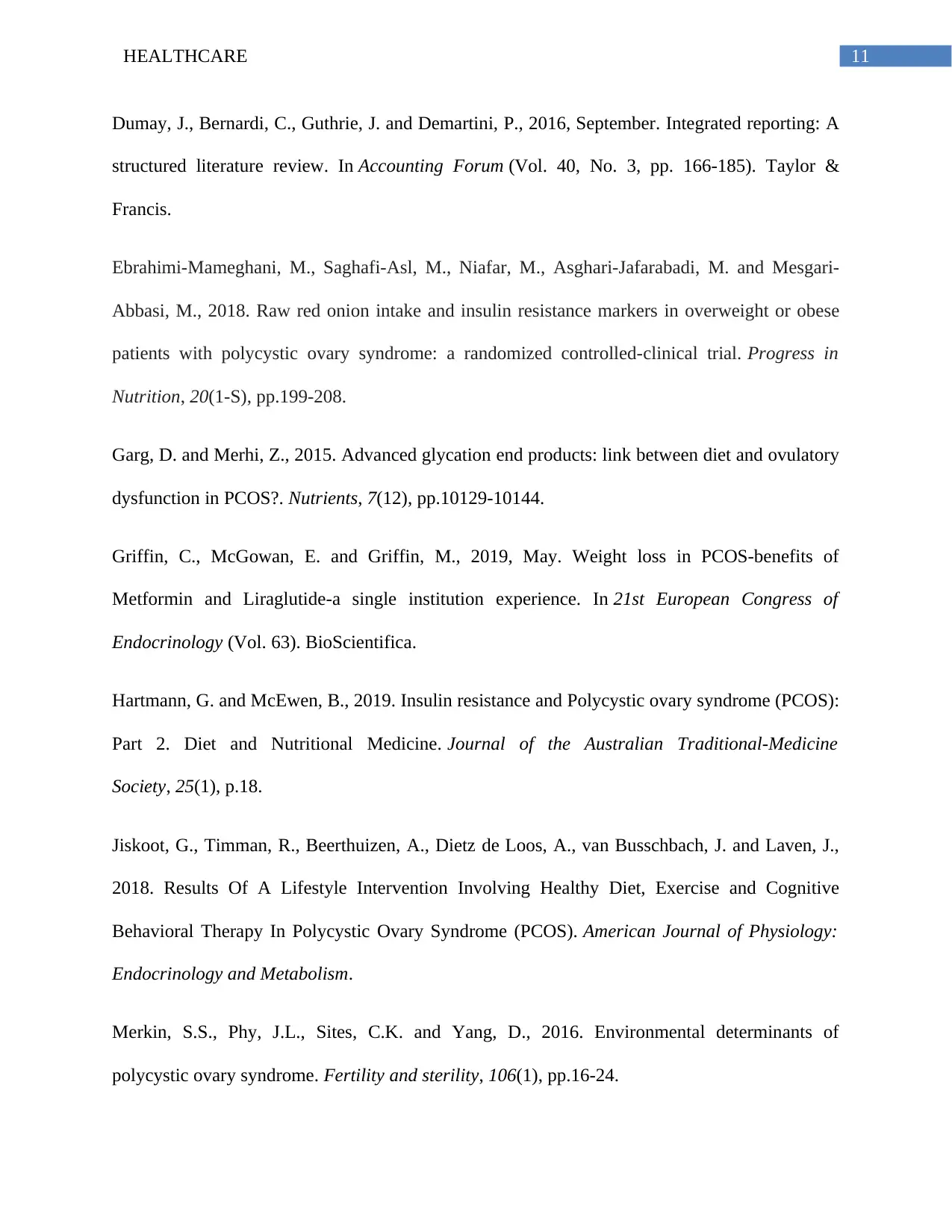
11HEALTHCARE
Dumay, J., Bernardi, C., Guthrie, J. and Demartini, P., 2016, September. Integrated reporting: A
structured literature review. In Accounting Forum (Vol. 40, No. 3, pp. 166-185). Taylor &
Francis.
Ebrahimi-Mameghani, M., Saghafi-Asl, M., Niafar, M., Asghari-Jafarabadi, M. and Mesgari-
Abbasi, M., 2018. Raw red onion intake and insulin resistance markers in overweight or obese
patients with polycystic ovary syndrome: a randomized controlled-clinical trial. Progress in
Nutrition, 20(1-S), pp.199-208.
Garg, D. and Merhi, Z., 2015. Advanced glycation end products: link between diet and ovulatory
dysfunction in PCOS?. Nutrients, 7(12), pp.10129-10144.
Griffin, C., McGowan, E. and Griffin, M., 2019, May. Weight loss in PCOS-benefits of
Metformin and Liraglutide-a single institution experience. In 21st European Congress of
Endocrinology (Vol. 63). BioScientifica.
Hartmann, G. and McEwen, B., 2019. Insulin resistance and Polycystic ovary syndrome (PCOS):
Part 2. Diet and Nutritional Medicine. Journal of the Australian Traditional-Medicine
Society, 25(1), p.18.
Jiskoot, G., Timman, R., Beerthuizen, A., Dietz de Loos, A., van Busschbach, J. and Laven, J.,
2018. Results Of A Lifestyle Intervention Involving Healthy Diet, Exercise and Cognitive
Behavioral Therapy In Polycystic Ovary Syndrome (PCOS). American Journal of Physiology:
Endocrinology and Metabolism.
Merkin, S.S., Phy, J.L., Sites, C.K. and Yang, D., 2016. Environmental determinants of
polycystic ovary syndrome. Fertility and sterility, 106(1), pp.16-24.
Dumay, J., Bernardi, C., Guthrie, J. and Demartini, P., 2016, September. Integrated reporting: A
structured literature review. In Accounting Forum (Vol. 40, No. 3, pp. 166-185). Taylor &
Francis.
Ebrahimi-Mameghani, M., Saghafi-Asl, M., Niafar, M., Asghari-Jafarabadi, M. and Mesgari-
Abbasi, M., 2018. Raw red onion intake and insulin resistance markers in overweight or obese
patients with polycystic ovary syndrome: a randomized controlled-clinical trial. Progress in
Nutrition, 20(1-S), pp.199-208.
Garg, D. and Merhi, Z., 2015. Advanced glycation end products: link between diet and ovulatory
dysfunction in PCOS?. Nutrients, 7(12), pp.10129-10144.
Griffin, C., McGowan, E. and Griffin, M., 2019, May. Weight loss in PCOS-benefits of
Metformin and Liraglutide-a single institution experience. In 21st European Congress of
Endocrinology (Vol. 63). BioScientifica.
Hartmann, G. and McEwen, B., 2019. Insulin resistance and Polycystic ovary syndrome (PCOS):
Part 2. Diet and Nutritional Medicine. Journal of the Australian Traditional-Medicine
Society, 25(1), p.18.
Jiskoot, G., Timman, R., Beerthuizen, A., Dietz de Loos, A., van Busschbach, J. and Laven, J.,
2018. Results Of A Lifestyle Intervention Involving Healthy Diet, Exercise and Cognitive
Behavioral Therapy In Polycystic Ovary Syndrome (PCOS). American Journal of Physiology:
Endocrinology and Metabolism.
Merkin, S.S., Phy, J.L., Sites, C.K. and Yang, D., 2016. Environmental determinants of
polycystic ovary syndrome. Fertility and sterility, 106(1), pp.16-24.
⊘ This is a preview!⊘
Do you want full access?
Subscribe today to unlock all pages.

Trusted by 1+ million students worldwide
1 out of 14
Related Documents
Your All-in-One AI-Powered Toolkit for Academic Success.
+13062052269
info@desklib.com
Available 24*7 on WhatsApp / Email
![[object Object]](/_next/static/media/star-bottom.7253800d.svg)
Unlock your academic potential
Copyright © 2020–2025 A2Z Services. All Rights Reserved. Developed and managed by ZUCOL.





